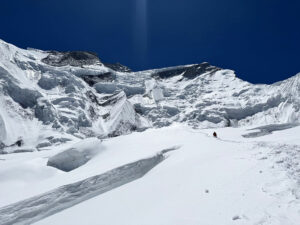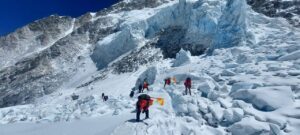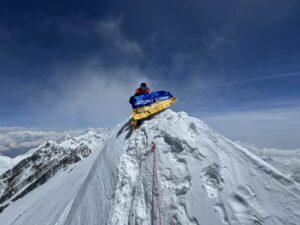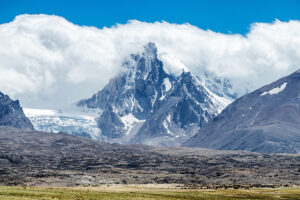In late 2019, ExplorersWeb revealed an uncomfortable truth about Manaslu. Almost every “summiter” that fall had not reached the mountain’s true summit. This lies at the end of a short knife-edged ridge, 20m long and 4 to 6m higher than the second-highest point. Only one person can do that picky ridge at a time, and in this industrial mountaineering era, where dozens of clients summit in a single day, that involves too much waiting. So virtually no one does it.
This true 8,163m summit is even more difficult to reach in fall because snow usually loads the arete after the monsoon, creating even more perilous footing. For large teams utterly dependent on fixed ropes, it is simply too technical.

Manaslu is a coveted peak for Himalayan climbers. Photo: Mingma G
In the last few years, commercial teams usually stopped at a slightly lower point, where ropes are easy to fix and there’s room for climbers to go up and down. After all, Nepal issues official summit certificates anyway, and up to now, even the Himalayan Database has accepted several points along the ridge as summits. So in 2019, nearly 500 people earned credit for reaching the top when no one did actually did. By then, research had already shown what was the highest point. Unlike in the early years, it wasn’t just an innocent mistake.
A high-altitude dilemma
In the words of the late lñaki Ochoa de Olza, a summit is “where everywhere you look is downhill.” While an “almost summit” of Manaslu suffices for individuals seeking an 8,000m experience, it should not be valid for those aiming for records or collecting the 14×8,000’ers.
One Manaslu climber told ExplorersWeb off the record that he has had nightmares with the report compiled by Eberhard Jurgalski of 8000ers.com and his team. Others have accepted the fact that if they want to complete all 14 of the 8,000m peaks, they will have to climb Manaslu again.

Climbers approach what looks like the highest point (C2) and where teams usually stop every year, but the true summit is hidden behind. Photo: Ralf Dujmovits, from Jurgalski’s Manaslu Summit Area report
The Himalayan Database is also considering changing its criteria, Billi Bierling told ExplorersWeb.
“I agree with the climbers who say that one must reach the highest point to consider it a summit,” she said. “It is just that in previous years, with Dhaulagiri, Annapurna, and Manaslu, there’s been a lot of confusion until really thorough studies came out.”
These studies drew on data from relatively new technologies that allowed more accurate measurements. “Now we need to make a decision,” says Bierling.
The problem is not just about recent climbs, but about all those historical achievements that actually fell a little short. Those climbers honestly thought that they were on top. Updating the stats would change the history of alpinism.

Manaslu’s summit ridge, with climbers on the true summit (marked as “4”). Photo: Guy Cotter from Jurgalski’s Manaslu Summit Area report
Tolerance but openness for future Manaslu summits
Jurgalski solicited feedback from the climbing community about whether only the true summit should count or whether a “tolerance zone” around it was acceptable. “Many simply do not know what to do about it,” Jurgalski admits.
Unlike an Olympic committee or other sporting body, mountaineering has no universally accepted entity in charge of setting the rules. So Jurgalski decided to dive in and make the decision himself. His conclusion:
- Create a tolerance zone around certain summits.
- In a historical table, note which climbers made it to the true summit and which fell a little short, and by how much.
- Future climbers need to document precisely where within this tolerance zone they stopped. Those who achieve the true summit may still be credited as the first from their country, the first woman, etc.

In spring, drier conditions permit a better recognition of Manaslu’s main summit. Photo: Toshio Imanishi, 1953, from Jurgalski’s Manaslu Summit Area report
His announcement opens the door for a slew of new firsts, which will undoubtedly snag the attention of many modern 8,000m collectors. But it also pressures future climbers to be transparent about how far they reach and recognizes that those who go all the way to the true top are summiters without asterisks.
Mingma G’s true summit expedition
In short, the level of difficulty on Manaslu has just increased significantly. And here is where Mingma G enters the scene.
The Nepali mountain guide and businessman (he owns Imagine Nepal, an expedition outfitter) has just announced a commercial climb to the “true” summit of Manaslu this September.
“Several climbers have claimed the summit but only a few (probably less than 15 climbers) have made it to the real/main summit,” Mingma G (Gyalgye Sherpa) wrote. “No commercial expedition wants to take clients to the main summit because of the tricky terrain.”
He includes himself in this indictment. “I have climbed Manaslu four times and all were to the foresummit, which is currently claimed as [the] final summit.”
He points out that most clients did not realize that there was a higher point beyond where they stood.

Mingma Gyalje Sherpa, aka Mingma G. Photo: Himali
So now, he is offering clients a chance to evade all controversy by reaching the true summit.
This proposal has pluses and minuses. On the plus ledger, it should appeal to anyone wanting a clean summit record. However, it is unclear how Mingma G will ensure his clients’ safety along the last 20m.
The actual difficulty will depend on conditions, but it’s hardly as simple as fixing a double set of ropes to permit progress in both directions. A single rope or belaying each individual is an option. But depending on the number of climbers, that may lead to a wait of many hours on the summit of an 8,000m peak. Picture each person inching by themselves along the knife-edge, touching the summit, and then inching back to allow the next one to proceed.
At least, Mingma G is highly experienced at this. Earlier this year, he led the rope-fixing work on a big part of Winter K2 and Annapurna, including the entire route from Camp 4 to the summit, with nearly 70 people behind him. No wonder he is eager to solve Manaslu’s new level of difficulty.






